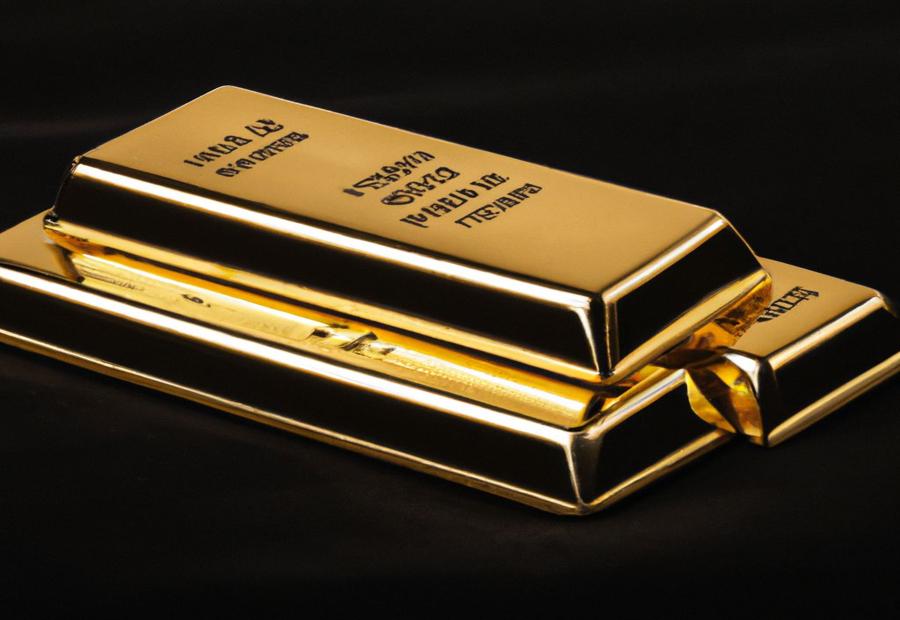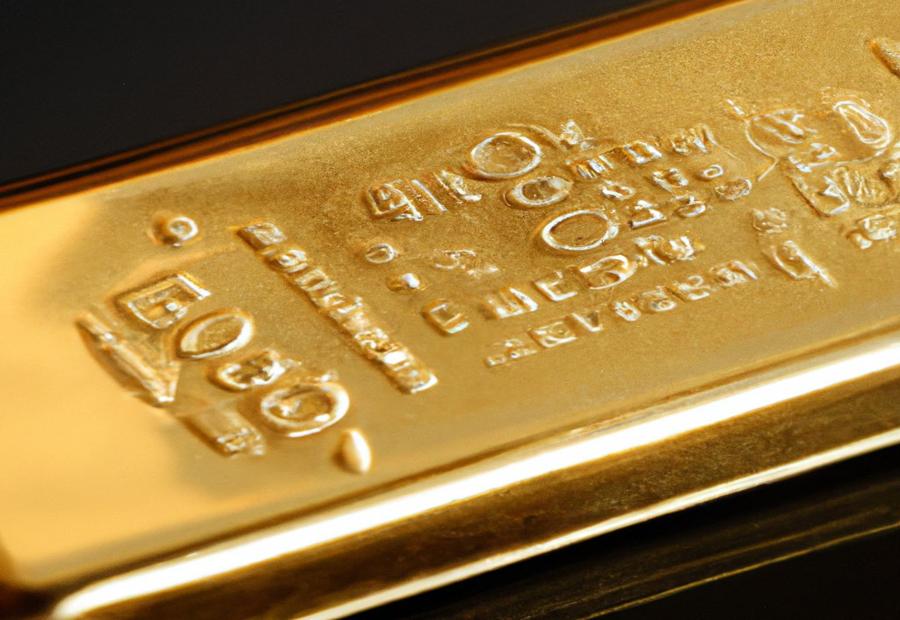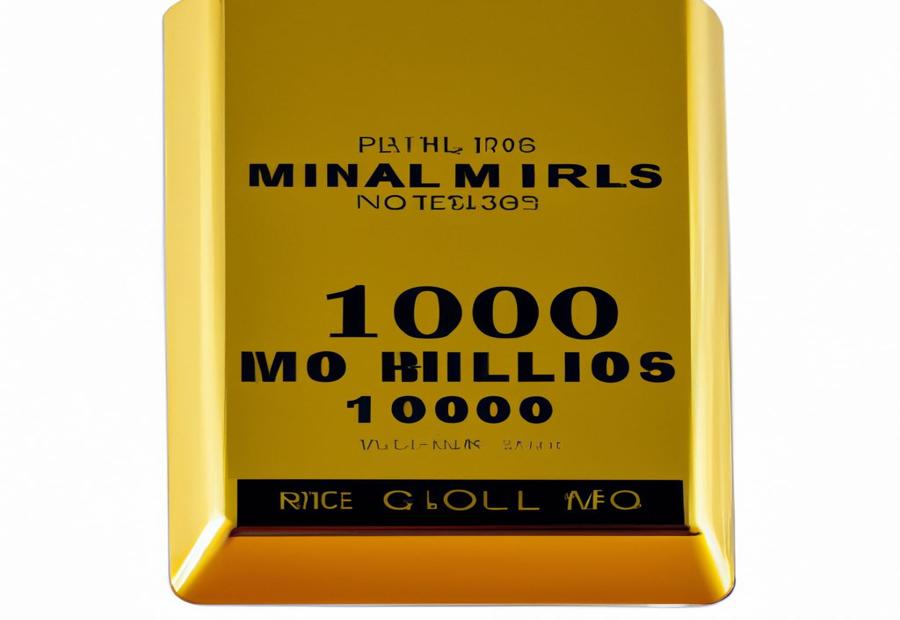Example 4:
Key Takeaway:
- The term “mills” in the context of gold value refers to one millionth of a troy ounce.
- To calculate the value of 100 mills of gold, one needs to convert mills to grams and determine the current price of gold per gram.
- The worth of 100 mills layered gold or silver can be evaluated by understanding the definition of 100 mills as a thickness measurement and recognizing the difference between “clad” and “plated” materials.
Introduction
Photo Credits: Ecopolitology.Org by James Taylor
Understanding the concept of “mills” in the context of gold value – In this section, we will unravel the mystery behind the term “mills” and how it relates to the worth of fine gold. Delving into the intricacies of gold valuation, we’ll explore the significance of “mills” and its impact on determining the value of 999 fine gold. Get ready to gain valuable insights that will shed light on this fascinating aspect of the gold market.
Understanding the concept of “mills” in the context of gold value
A mill, when it comes to gold value, stands for one millionth of a troy ounce. To understand how “mills” relate to gold, we need to learn about converting troy ounces to grams. This conversion helps us work out the weight of gold in grams for each troy ounce. A mill equals one millionth of that weight. After understanding this conversion and its importance, 100 mills of gold can be calculated with more accuracy.
Making gold math even more confusing just to keep us on our toes!
Explanation of the conversion factor from troy ounce to grams
Troy ounces and grams are two different units of measurement. One troy ounce is equal to around 31.1035 grams. This conversion factor may vary a bit, but typically it is accurate.
It is important to understand this conversion factor when calculating the value of gold or any other precious metal. Converting the weight from troy ounces to grams allows for easier comparison of prices across various markets and currencies.
Even though it doesn’t sound big, one mill is a millionth of an ounce and can be very valuable when it comes to gold.
Definition of a “mill” as one millionth of a troy ounce
A “mill” is one millionth of a troy ounce of gold. This makes it easier to measure and calculate gold quantities.
So, let’s figure out what 100 mills of gold are worth! Math and precious metals come together here, bringing us the dazzling world of money confusion.
Calculating the value of 100 mills of gold
Photo Credits: Ecopolitology.Org by Lawrence Smith
When it comes to determining the value of 100 mills of gold, there are several crucial factors to consider. In this section, we will explore the process of calculating this value by covering topics such as the conversion of mills to grams, determining the current price of gold per gram, and the necessary calculations involved. By understanding these concepts, you’ll gain a better grasp of how much 100 mills of 999 fine gold is truly worth.
Conversion of mills to grams
Gold is usually measured in troy ounces. But it can also be in grams. A “mill” is a tiny unit of measurement. It is one millionth of a troy ounce. It is used to measure the weight or thickness of gold. To switch from mills to grams, we must know the conversion factor from troy ounces to grams.
Attempting to find out the value of 100 mills of gold is like finding amusement in a gloomy room – almost impossible.
Determining the current price of gold per gram
Including the given keywords, we can say:
One must know the conversion from troy ounce to grams. Additionally, one must be aware of the current market price per gram of gold. This price depends on the supply and demand of the gold market. To calculate the worth of 100 mills of gold, you need to know the current price of gold per gram. It is important to note any changes in the market price, since it affects the worth of gold.
To be able to accurately assess the worth of gold, you must consider both the conversion factor and the current market price of gold per gram. These factors are vital to understanding the value of gold before taking part in any transactions or investments involving gold bars or coins.
Calculation of the value of 100 mills of gold
To calculate the value of 100 mills of gold, start by converting mills to grams. This is done by using a conversion factor from troy ounce to grams. Then, determine the current price of gold per gram. Finally, multiply the weight in grams by the price per gram.
The following table summarizes the calculation process:
| Step | Calculation |
|---|---|
| 1 | Conversion: Mills to Grams |
| 2 | Determining Current Price: Gold Per Gram |
| 3 | Calculation: Value = Weight (in grams) x Price per Gram |
It’s important to note that 100 mills layered gold or silver bars cannot be sold to gold companies due to their lack of purity and authenticity. They are mainly valued for their aesthetics rather than their intrinsic precious metal worth.
Before investing in or purchasing such items, evaluate their true worth. Be aware of their actual monetary value and potential limitations. This knowledge helps to avoid disappointment and misjudgment in transactions involving mill-layered metals like these bars.
Evaluating the worth of 100 mills layered gold or silver
Photo Credits: Ecopolitology.Org by Matthew Garcia
Evaluating the worth of “100 mills” layered gold or silver unveils the truth behind its value. From understanding the thickness measurement to clarifying the terms “clad” and “plated,” we will explore the real value that lies within these bars. Get ready to uncover the facts and debunk the misconceptions surrounding the true worth of 100 mills layered gold or silver.
Definition of 100 mills as a thickness measurement
Investigating gold value and its measurement, it’s key to understand “mills“. This is a unit that equals one millionth of a troy ounce. In gold, “100 mills” represents a thin layer or coating of the same thickness.
When talking about gold pieces, people often use words like “clad” and “plated“. Clad implies multiple layers, while plated refers to a thin surface on another material. Both can have 100 mills layers.
But, these bars may not be worth what they appear to be. Their true value often lies in their collectible worth rather than the metal content. That’s why they can’t usually be exchanged for genuine gold. People should only transact with verifiable quantities of precious metal.
Clarifying the terms “clad” and “plated”
Clad and plated are terms used to describe when a thin layer of gold or silver is applied to a base metal. This is often done to make bars and coins more visually appealing. The layer of precious metal is usually only a few microns thick.
Clad means the base metal has a complete cover of precious metal. If cut, the core material would be seen. Plated means the base metal has a thin layer of precious metal. If scratched or worn down, the base metal would be visible.
Clad and plated products have some aesthetic value, but they do not hold the same intrinsic value as solid gold or silver. They are usually sold at lower prices due to their manufacturing process and composition.
It’s important to understand the terms clad and plated and their implications on value when investing in gold or silver. It’s also a good idea to consult with reputable sources when buying such products to ensure transparency and informed decision-making.
Understanding the actual value of the gold in these bars
Essential to understanding the true value of gold bars is grasping the conversion factor from troy ounce to grams. Plus, one must comprehend the definition of a ‘mill’ as one millionth of a troy ounce.
Converting mills to grams and determining the current price of gold per gram enables accurate calculations of the value of 100 mills of gold.
Gold market prices inform people of the worth of each gram of gold. Together with the conversion factor, this knowledge helps calculate the value of 100 mills of gold.
It is important to remember that these bars may be labeled as 100 mills layered gold or silver. The terms “clad” and “plated” imply they are not made of pure gold, but coated with a thin layer. Thus, assessing their worth involves thickness measurement and understanding of potential lower purity.
Selling these bars to reputable gold companies may prove difficult. Due to composition and lower purity than solid gold bars, most buyers will not accept them at face value. Those interested in investing in precious metals should bear this in mind and explore other options.
Limitations of 100 mills layered gold or silver
Photo Credits: Ecopolitology.Org by Anthony Wilson
Limitations of 100 mills layered gold or silver: Discover the reasons why selling these bars to gold companies can be challenging and learn how to differentiate between their collectible value and their actual precious metal value.
The inability to sell these bars to gold companies
100 Mills layered gold or silver bars are highly collectible. However, they contain very little of the actual precious metal, equivalent to just one millionth of a troy ounce. Gold companies are not interested in these bars due to the minimal precious metal content. These bars appear solid, but they are actually just “clad” or “plated” with a thin layer of gold or silver.
What’s important to note is that “100 mills” refers to the thickness measurement of these bars. It doesn’t refer to the quantity or quality of the gold or silver within them. Plus, these bars are usually clad or plated with a very thin layer of gold or silver.
These bars have some appeal as collectibles, but it’s important to realize that their worth is primarily based on their limited edition design and aesthetic appeal, not their inherent precious metal value. Gold companies focus on acquiring and selling pure gold or silver in large quantities, so individuals who possess 100 Mills layered gold or silver bars should not expect them to be valuable in terms of precious metals trading. It’s like trying to gauge the worth of a Picasso painting by weighing the frame.
Recognizing the collectible value vs. precious metal value
It is important to know the difference between collectible value and precious metal value. Precious metal value refers to the value of gold or silver according to its weight and purity. But, collectible value takes into account other things, such as rarity, historical meaning, and aesthetic appeal.
Let’s look at a comparison:
| Criteria | Collectible Value | Precious Metal Value |
|---|---|---|
| Rarity | High | Standard |
| Historical Significance | Significant | Not Applicable |
| Aesthetic Appeal | Desirable | Not Applicable |
| Market Demand | Variable | Constant |
The table shows that each value may differ. But, this doesn’t diminish the importance of the metal value. This value is still essential when figuring out how much an item is worth.
Conclusion and final thoughts
Photo Credits: Ecopolitology.Org by John Davis
Gold is a valuable metal that retains its worth. The value of 100 mills 999 fine gold can alter based on the gold market. 100 mills measure the thickness of the gold layer, around one-tenth of a gram. 999 fine gold stands for 99.9% pure gold. So, the value of 100 mills 999 fine gold mainly depends on the current price of gold.
The worth of gold adjusts daily due to different reasons, such as economic conditions, global events, and market demand. It is essential to stay informed on the current price of gold to determine the value of 100 mills 999 fine gold precisely. Collectors and investors often think about the purity and weight of gold when considering its value. The higher the purity, the more valuable the gold is.
It is vital to be aware of the risks and uncertainties connected with investing in gold. While gold is seen as a safe haven asset, its worth can also be swayed by market speculation and investor sentiment. It is wise to consult with a dependable dealer or financial advisor for correct data and advice on investing in 100 mills 999 fine gold.
Don’t miss out on the chance to invest in 100 mills 999 fine gold. With its purity and potential for long-term value, it can be a great part of your investment portfolio. Keep up with the current price of gold and consider getting expert advice to make the most informed investment decisions. Begin your journey into the world of gold investment now and grasp the potential benefits it offers.
Some Facts About How Much Is 100 Mills 999 Fine Gold Worth:
- ✅ 1 MILL of gold is worth approximately $0.13. (Source: Team Research)
- ✅ 100 mills layered gold or silver refers to a plating that is 1.2 microns or thicker. (Source: Team Research)
- ✅ The actual value of the gold in these bars is around $0.02. (Source: Team Research)
- ✅ Gold companies do not accept these bars as their removal costs more than the value of the gold. (Source: Team Research)
- ✅ 100 mills 999 fine gold bars have collectible value but no significant precious metal value. (Source: Team Research)
FAQs about How Much Is 100 Mills 999 Fine Gold Worth
FAQ 1: What is the previous metal value of 100 mills 999 fine gold?
Answer: The previous metal value of 100 mills 999 fine gold is approximately $0.02. However, please note that gold companies will not accept these bars as their cost of removing the gold plating is higher than the actual value of the gold.
FAQ 2: How much is 100 mills 999 fine gold worth in the open market?
Answer: In the open market, 100 mills 999 fine gold has a low value. The actual value of the gold in these bars is around $0.02. Therefore, these bars are primarily valuable for their collectible value and do not have any significant precious metal value.
FAQ 3: What does “100 mills” mean when referring to gold?
Answer: When the term “100 mills” is used in relation to gold, it means that the bar is plated with a layer of gold that is 100 millionths of an inch thick. This means the gold plating is very thin and has a low intrinsic value.
FAQ 4: Can I sell 100 mills 999 fine gold for its precious metal value?
Answer: No, gold companies will not accept 100 mills 999 fine gold bars for their precious metal value. The cost of removing the gold plating is higher than the value of the gold itself. These bars are mainly valuable for their collectible value and not their precious metal content.
FAQ 5: What is the collectible value of 100 mills 999 fine gold?
Answer: The collectible value of 100 mills 999 fine gold is subjective and can vary. Some individuals may be willing to pay a small amount for these bars due to their novelty or aesthetic appeal. However, the actual intrinsic precious metal value is very low.
FAQ 6: Why are 100 mills 999 fine gold bars not considered valuable in the open market?
Answer: 100 mills 999 fine gold bars are not considered valuable in the open market primarily because the gold plating is very thin, at 100 millionths of an inch. The cost of removing the gold plating is higher than the actual value of the gold, making these bars unappealing to gold companies and those seeking precious metals.

.jpg)




